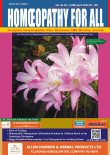Homeopathic Management of Anosmia
Keywords:
Anosmia, equilibrium, parosmiaAbstract
Anosmia, defined as the loss of the sense of smell, can significantly impair an individual's quality of life; however, its importance is frequently underestimated. The sense of smell is crucial for both the appreciation of daily experiences, such as food and nature, and for the identification of potential dangers, including gas leaks and spoiled food. The failure to detect these odors may jeopardize safety and well-being. Anosmia can arise from multiple etiologies, such as viral infections, nasal obstructions, or neurodegenerative disorders, including Alzheimer's and Parkinson's diseases. The prevalence of smell loss is significant among older populations, with approximately 3.2% of U.S. adults over 40 affected, a statistic that increases to 14–22% in individuals over 60. Anosmia is frequently unrecognized, primarily due to the absence of formal olfactory testing in routine health examinations, resulting in patients relying on self-reporting of their symptoms.
Downloads
References
1. Schäfer, L., Schriever, V. A., & Croy, I. (2021). Human olfactory dysfunction: causes and consequences. Cell and Tissue Research, 383, 569-579.
2. Yousem, D. M., Geckle, R. J., Bilker, W., McKeown, D. A., & Doty, R. L. (1996). MR evaluation of patients with congenital hyposmia or anosmia. AJR. American journal of roentgenology, 166(2), 439- 443.
3. Caminiti, F., Ciurleo, R., De Salvo, S., Galletti, F., Bramanti, P., & Marino, S. (2019). Olfactory event-related potentials in a functionally anosmic patient with arrested hydrocephalus. Journal of International Medical Research, 47(3), 1353-1358.
4. Eroglu, U., Shah, K., Bozkurt, M., Kahilogullari, G., Yakar, F., Dogan, İ., ... & Ugur, H. C. (2019). Supraorbital keyhole approach: lessons learned from 106 operative cases. World neurosurgery, 124, e667-e674.
5. Huang, X., Sterling, N. W., Du, G., Sun, D., Stetter, C., Kong, L., ... & Mailman, R. B. (2019). Brain cholesterol metabolism and Parkinson’s disease. Movement Disorders, 34(3), 386-395.
6. Dintica, C. S., Marseglia, A., Rizzuto, D., Wang, R., Seubert, J., Arfanakis, K., ... & Xu, W. (2019). Impaired olfaction is associated with cognitive decline and neurodegeneration in the brain. Neurology, 92(7),
e700-e709.
7. Lüers, J. C., Klußmann, J. P., & Guntinas-Lichius, O. (2020). Die Covid-19- pandemie und das HNO Fachgebiet: Worauf kommt es aktuell an?(The Covid-19 pandemic and otolaryngology: what it comes down to?). Laryngorhinootologie, 99(5), 287-91.
8. Li X, Lui F. Anosmia. [Updated 2023 Jul 3]. In: StatPearls [Internet]. Treasure Island (FL): StatPearls Publishing; 2024 Jan-. Available from: https:// www.ncbi.nlm.nih.gov/books/ NBK482152/
9. W. Boericke, New Manual of Homoeopathic Materia Medica & Repertory [with Relationship of Remedies], Second Re
Augmented & Revised Edition Based on Ninth Edition, Reprint Edition 2002, B. Jain Publishers, New Delhi.
10. J. H. Clarke, Dictionary of Practical Materia Medica, Reprint Edition 1992, B. Jain Publishers, New Delhi.




